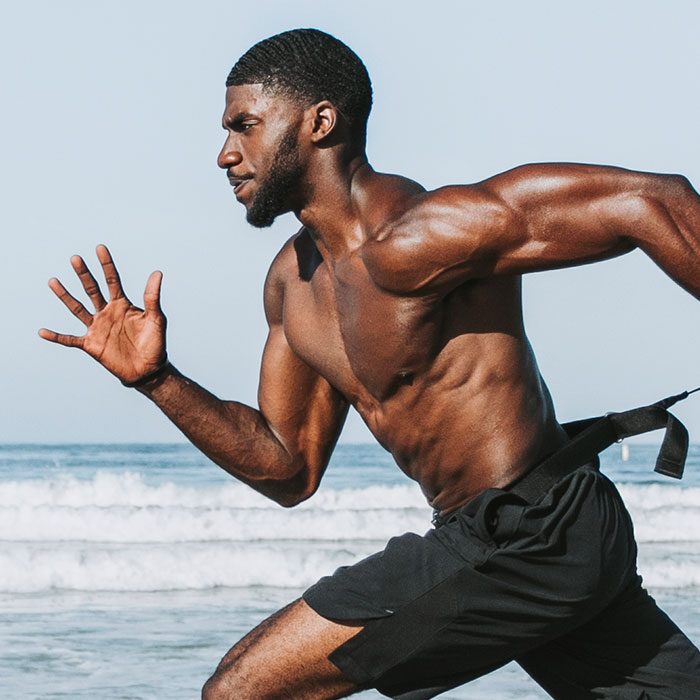Keys to an Explosive Start
In this blog post, we will discuss the keys to an explosive start with and without the block. If you are familiar with the world of speed, you have heard the names of Christian Coleman and John Ross. Both of them are known for their explosive starts.
In this piece, we’ll analyze and break down the techniques these sprinters follow and try to learn some important lessons that we can use to help you improve your sprinting. These techniques include stance, hips, and spine positions in the push-off, first step contact time, and push-off. We’ll also look at the head position during the process.
In order to better understand these mechanics, I’ll highlight the keys that you need to learn so that you can get that explosive start you’ve always wanted.
Hips and Spine in the Push Off
When starting your sprint, as you push off, most of the coaches tell you to keep your heads down. However, if you’ve ever noticed John Ross, you’d notice that his head rises up as he is exploding off the line. It’s crucial to stay low during the first few steps after the push-off, but the head is rising during the first step, however, you do need to keep your chin down.

Christian Coleman’s spine position is worth noticing during the start of the sprint. He reorganizes and readjusts his spine position and his spine is much higher than that of his counterparts. In the process, he pushes forward his bodyweight too. This allows him to create a horizontal action and this is the key to an explosive start.

Your spine should be stable as you drive through with the motion. The arms range is also important. And that is going to be our next big key to an explosive start.

Check Out Our Blog On How To Increase Top Speed
Arms Range and Motion
As you begin to run, you should drive your arm back and the opposite arm should drive all the way up. The range of the arm is a crucial aspect to consider when sprinting. You want to make sure there’s plenty of range on both sides of your arms.

This motion helps your legs go, many people don’t realize this and DO NOT focus on improving the arms’ range of motion during start. Your arms should be able to get all the way through during the initial action. It can also help get your body weight projecting forward as you start. The majority of the push-off should become a horizontal motion instead of a vertical one.
Foot, Toe Range, and Ankle Stability
At the start of your sprint, most of your weight should be the front of your back foot to easily transition weight off that leg. Most of the weight is in the middle/slightly forward in the front foot. The more range you have in the ankles the longer you will be able to keep the foot down leading to a more horizontal push off. The distance between your head and your back heel should be as far as possible to maximize distance in the step.
To improve your turnover speed, read more here.

As you start your sprint the heel in your first step should be low as it is driving forward. This allow the foot to project out in front of the body and gives you the opportunity to create horizontal force into the ground when landing. When you land on your front foot, you need to make sure it’s stable which means limited movement during foot contact and the transition phase. Additionally, you should not have your foot flat on the ground and that’s super important here.

As a sprinter, you want to make sure that as you take the first step you land on your toes and your heel stays high and underneath your hip. The entire motion needs to be stable so that you are able to generate force off the ground.
Here Is Another Great Article On The Most Active Muscles While Sprinting
John Ross vs Christian Coleman
If you’re looking for a great block start, you should watch some of the videos of Christian Coleman to get a better idea of what I’ve explained above. However, John Ross is good if you’re looking for a three-point stance and doing a 40.
Both of them are excellent sprinters and Christian Coleman is one of the fastest people in the world. Observing their techniques more closely can certainly give you an edge over your competitors in your sprint. The key in my opinion is that you film your start and try different variations of what I said above to help you improve your specific start. Everyone is different so based on your height and leg to torso ratio, you are going to have different numbers.
Top 10 Secrets To Improve Speed Immediately | Sprint Mechanics
Final Words
I hope you found these tips and techniques helpful. I tried to convey the keys to an explosive start (block start) in a nutshell by highlighting the sprinting techniques of two of the best runners in the world. If you are looking for more information about sprinting feel free to visit our official website and explore sprinting programs.
You might also want to check out: Why Is Jamaica So Good At Sprinting? Read here.
We help you achieve your best by giving you techniques and also giving you breakdowns of your runs. So if you’re someone who is interested in improving their sprinting mechanics quickly, send us an email or give us a call and we will most definitely be able to help!
Our Simple Speed Coaching Process To Help You Get Faster
STEP 1. SEND IN VIDEO OF YOUR SPRINT VIDEO
This is easy we send you a video to explain what angles to send and how to upload onto our server quickly and easily. You will be able to upload right from your computer or smart device.
STEP 2. RECEIVE SPEED COACHING BREAKDOWN OR ZOOM CALL
Within 24 hours you will get a detailed email back that goes over all the critical details of your running form. This will include drills and exercises to help you improve. If you have any questions we can always schedule a call to make sure everything is clear and concise.
STEP 3. FOLLOW THE SPEED PROGRAM AND MAKE THE CHANGE
Now we will make everything as easy as possible for you to be able to make tremendous improvement in your mechanics. Our speed training programs have tons of drills and exercise to help you improve. However, you must DO THE WORK. YOU WILL GET OUT WHAT YOU PUT IN.
Follow us on social media to get updated:









